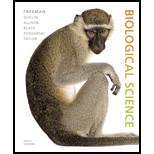
Concept explainers
Which of the following occurs when a covalent bond forms?
a. Electrons in valence shells are transferred from one atom to another.
b. Electrons in valence shells are shared between atoms.
c. Partial charges on polar molecules interact.
d. Nonpolar molecules are pushed together by surrounding water molecules.
Introduction:
Covalent bonds are formed by sharing of the electron pairs between atoms. These electron pairs are referred to as shared pairs or bonding pairs. The chemical bond in which the complete transfer of electron present in the outer shell takes place is known as an ionic bond.
Answer to Problem 1TYK
Correct answer:
Electrons in valence shells are shared between atoms.
Explanation of Solution
Explanation/Justification for the correct answer:
Option (b) is given that the bond is formed by the electron sharing. Covalent bonding occurs when pairs of electrons are shared between atoms. Atoms are covalently bond with other atoms by forming a full electron shell providing more stability. By sharing their outer most (valence) electrons, atoms can fill up their outer electron shell and gain stability. Hence, option (b) is correct.
Explanation for incorrect answers:
Option (a) is given that the valence shells are transferred. The chemical bond, in which the complete transfer of electron present in the outer shell occurs is known as an ionic bond. So, it is incorrect answer.
Option (c) The polar molecules have partial charges present on them, the interaction of the two-partial charged atoms results in the formation of the dipole-dipole interaction. It takes place when two molecules carry opposite partial charge. So, it is incorrect answer.
Option (d) The interaction between the water and the non-polar molecule, in which the non-polar molecules attract themselves is known as hydrophobic interaction. These molecules do not form bonding with the water molecules, as a result, they are forced to interact among themselves. So, it is incorrect answer.
Hence, options (a), (c) and (d) are incorrect.
Covalent bonds are formed when electrons are shared between atoms.
Want to see more full solutions like this?
Chapter 2 Solutions
Biological Science (6th Edition)
- The type of bonding that happens between atoms within a water molecule is which of the following? a. Polar covalent bonding b.ionic bonding c. Non polar covalent bonding d. Hydrogen bondingarrow_forwardWhich of the following does NOT involve non-covalent interactions? a.Interaction between salt and water b.3D structure of a protein c.Interaction between a ligand and protein d.The synthesis of macromoleculesarrow_forwardFats do not dissolve in water because Select one: a. There are no C-H bonds to form hydrogen bonds with water b. There are no O-H bonds form hydrogen bonds with water c. There are no C-C bonds to form hydrogen bonds with water d. There are no C-H bonds for covalent bonds with water e. There are no C-C bonds to form covalent bonds with waterarrow_forward
- Compare nucleic acids with polysaccharides. Which of the following is NOT true? Group of answer choices A) Both have monomers that contain simple sugars. B) Both function as structural support for cells. C) Both types of molecules are organic. D) Both are polymerized by dehydration reactions. .arrow_forwardThis occurs when the cations and anions are attracted to the positive and negative ends of water molecules: A. ionic bonding B. dissociation C. covalent bonding D. hydrogen bondingarrow_forwardWhich statement is true of all atoms that are anions?(A) The atom has more electrons than protons.(B) The atom has more protons than electrons.(C) The atom has fewer protons than does a neutral atomof the same element.(D) The atom has more neutrons than protons.arrow_forward
- Which of the following statements is not true? a. Water is polar. b. Water stabilizes temperature. c. Water is essential for life. d. Water is the most abundant atom in Earth’s atmosphere.arrow_forwardManufacturers make carbonated drinks by forcing pressurized carbon dioxide gas into flavored water. A chemical reaction between water molecules and some of the CO2 molecules creates hydrogen ions (H+) and bicarbonate, which is a buffer. In your opinion, is this reaction likely to raise the pH of a soda above 7, or lower it? Give your reasoning.arrow_forwardWhich type of bond represents a weak chemical bond? a. hydrogen bond b. ionic bond c. covalent bond d. polar covalent bondarrow_forward
- Atoms share electrons unequally in an _______ bond. a. ionic c. polar covalent b. hydrogen d. nonpolar covalentarrow_forwardWhat is an alloy? A. A compound of two metals B. An element of two metals C. A mixture of two metals D. A molecule of two metalsarrow_forwardWhich of the following statements is incorrect? a. Isotopes have the same atomic number and different mass numbers. b. Atoms have about the same number of electrons as protons. c. All molecules consist of atoms. d. Free radicals are dangerous because they emit energyarrow_forward

 Concepts of BiologyBiologyISBN:9781938168116Author:Samantha Fowler, Rebecca Roush, James WisePublisher:OpenStax College
Concepts of BiologyBiologyISBN:9781938168116Author:Samantha Fowler, Rebecca Roush, James WisePublisher:OpenStax College Biology Today and Tomorrow without Physiology (Mi...BiologyISBN:9781305117396Author:Cecie Starr, Christine Evers, Lisa StarrPublisher:Cengage Learning
Biology Today and Tomorrow without Physiology (Mi...BiologyISBN:9781305117396Author:Cecie Starr, Christine Evers, Lisa StarrPublisher:Cengage Learning Biology (MindTap Course List)BiologyISBN:9781337392938Author:Eldra Solomon, Charles Martin, Diana W. Martin, Linda R. BergPublisher:Cengage Learning
Biology (MindTap Course List)BiologyISBN:9781337392938Author:Eldra Solomon, Charles Martin, Diana W. Martin, Linda R. BergPublisher:Cengage Learning Human Biology (MindTap Course List)BiologyISBN:9781305112100Author:Cecie Starr, Beverly McMillanPublisher:Cengage Learning
Human Biology (MindTap Course List)BiologyISBN:9781305112100Author:Cecie Starr, Beverly McMillanPublisher:Cengage Learning




